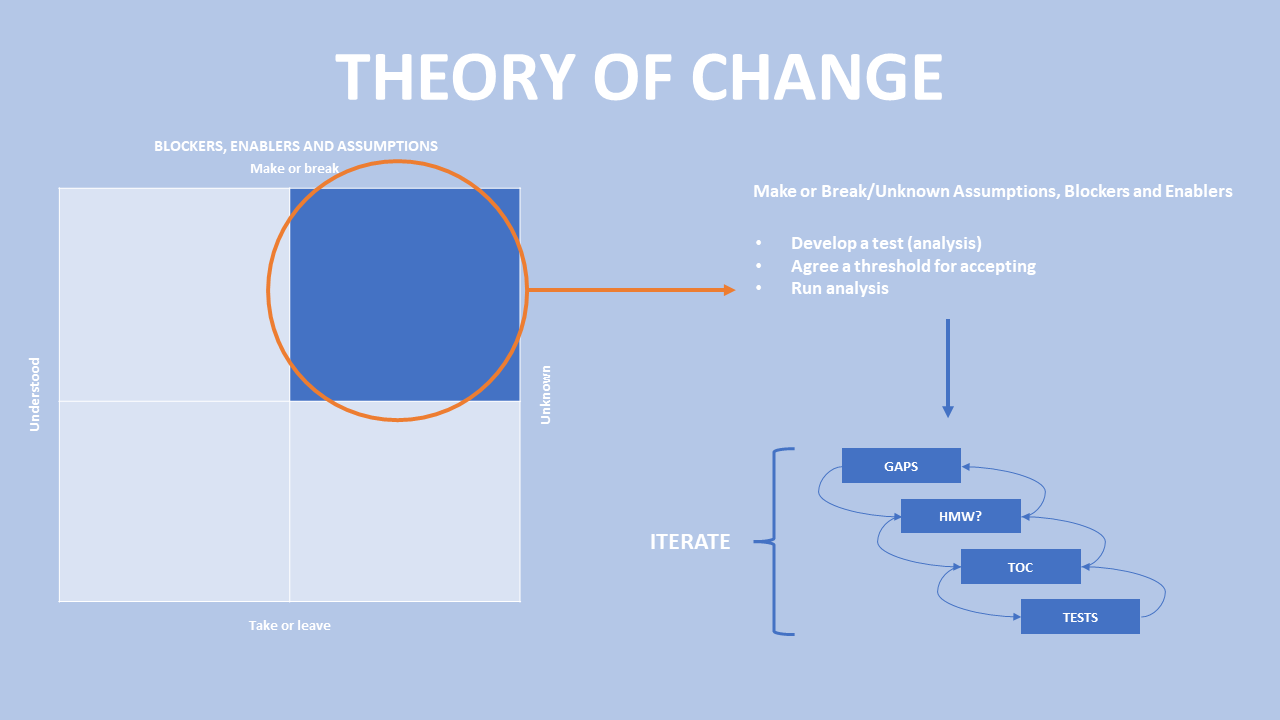In the first installment of this three-part series on Grounded EthnoDesign (GED), we discussed the critical role of problem identification and framing within our integrated strategy formulation approach. We explored how GED begins by understanding an organisation's institutional ambition and how it leverages insights from internal and external stakeholders to frame the problems that hinder the fulfillment of these ambitions.
In this article we shift our focus from problem identification to solution development. Here, the framed problems, transformed into "How Might We" (HMW) questions, become the springboard for ideating potential solutions. These solutions serve as the building blocks for creating a Theory of Change (ToC), a roadmap leading the organisation towards its desired future.
This article will look at the intricacies of the solution development phase of GED, exploring the processes of ideation, ToC development, assumption testing, and iterative refinement of a strategy. We will see how GED's systematic and inclusive approach enables the creation of effective strategies aimed at solving an organisation's most pressing problems and steering it towards its institutional ambition.
From Problems to Solutions: A Recap
We have already seen ho GED starts with a clear understanding of an organisation's institutional ambition and proceeds with the identification and framing of problems. At the heart of this process is the transformation of these problems into "How Might We" (HMW) questions.
The HMW questions emerge from a creative re-framing of organisational problems. A problem statement such as "We are losing research funding due to inadequate retention of research talent" becomes "How might we improve our retention of research talent to attract additional funding?" These questions are intentionally broad and open-ended, designed to inspire innovative thinking and open the door to a wide range of potential solutions.
This transformational step creates a solid foundation for the ideation of solutions. By re-framing problems as HMW questions, we shift the focus from the constraints and limitations of the problems to the expansive possibilities of solutions. This shift in mindset sparks creativity, paving the way for a diverse range of ideas to emerge.
This is a pivotal transformation from problems into questions and is instrumental in preparing the ground for the ideation process. HMW questions ensure that the next phase is guided by well-framed questions that not only capture the essence of the problem but also inspire innovative solutions.
Ideating solutions
With problems effectively transformed into "How Might We" (HMW) questions, we approach the ideation phase in GED. Ideation, in essence, is the systematic generation of potential solutions to the HMW questions. It's a creative and expansive phase where the focus is on breadth, not depth. The aim is to generate as many ideas as possible, encouraging an open mind and innovative thinking.
The importance of ideation in the GED process cannot be overstated. It serves as the bridge between the current outcomes and the organisation's institutional ambitions. It's through ideation that a range of potential strategies to achieve these ambitions is identified. By encouraging a broad scope of ideas, the ideation phase allows for the inclusion of both conventional and radical solutions, providing a robust set of potential strategies for the organisation to consider.

There are various creative techniques and methodologies we commonly employ during this phase. These range from individual brainstorming and mind mapping to more collaborative techniques like design thinking workshops and facilitated sessions. These techniques aim to create an environment that fosters creative thinking and encourages the free flow of ideas.
One of the key factors we have come to understand in this phase is that it needs to include a broad group or participants representing different corporate functions, from IT, finance, HR, external relations etc. Too often, solution design for research strategy si siloed inside of the research portfolio. This provides a narrow view of the world constrained by a limited understanding of the organisational operating context, constraints, possibilities etc. A broader representation from across the research organisation presents a much more valuable input into ideation. It also helps to gain buy-in for initiatives that may follow from the strategy, which helps when it comes to actually implementing a stratgey.
The ideation phase, with its focus on innovative and expansive thinking, is a crucial part of the journey from problem identification to solution development. This stage serves as the springboard for the next critical step in the process: developing a Theory of Change (TOC).
Developing a Theory of Change
Once a diverse set of potential solutions has been brainstormed, the next critical stage in the GED process is to develop a Theory of Change (ToC). The ToC is a comprehensive description and illustration of how and why a desired change is expected to happen in a particular context. It provides a roadmap that outlines the steps necessary to transition from the current state to the envisioned future state as indicated by the organisation's institutional ambition.
Developing a ToC involves a detailed exploration of solutions. Solutions are dissected to understand their impact, the resources required, and the stages through which it will transition to achieve the desired change. This process includes detailing the short-term, intermediate, and long-term outcomes. Perhaps more improtantly, it identifies the assumptions, including the blockers and enablers, that underpin our beliefs about how the world works, and how we believe we can take action to change it towards our institutional ambition. The end result is a robust ToC that articulates the steps, outcomes, and assumptions of the journey from the present state to the desired future.
The ToC plays a crucial role in GED's integrated strategy formulation process. It connects the ideation stage with the subsequent stages of testing assumptions and identifying barriers. The ToC also provides a reference point for continuous monitoring and evaluation, ensuring that the strategy remains on track towards achieving its goals. In essence, the ToC provides structure to the creative solutions birthed in the ideation phase, translating them into strategic moves that guide the organisation towards its institutional ambitions.
Testing Assumptions and Identifying Barriers
Building on the ToC, the next step is testing the assumptions underpinning the ToC and identifying potential barriers to change. Each solution within the ToC is based on certain assumptions that anticipate a successful transition from the current state to the desired state. However, assumptions are not guarantees; they are beliefs that need rigorous testing to validate their accuracy.
Testing assumptions involves analysing each presumption critically and objectively to assess its validity. This process might involve quantitative or qualitative data analysis, scenario planning, or further stakeholder consultations. This step is vital as it ensures the realism and practicality of the proposed solutions. If an assumption is found to be weak or false, it can be revised, or alternative solutions may need to be explored.
Simultaneously, it's crucial to identify potential barriers that could impede the process of change. These barriers could be internal, such as resource constraints or resistance to change, or external, like regulatory issues or market competition. Identifying these barriers upfront allows for proactive planning and mitigation. If a barrier is found to be insurmountable, then a solution is impractical and should be abandoned at this point, and alternatives explored.
At this stage, external stakeholder interviews are reintroduced. Their perspectives help validate or challenge the assumptions and barriers identified, providing valuable insights that further refine the strategy. Through this rigorous testing process, GED ensures that the eventual strategy is not just innovative and ambitious, but also firmly grounded in reality, increasing the likelihood of its successful implementation.
The Imprtance of Iteration
Once we begin testing our assumptions and identifying barriers, our process enters an inevitable phase of iteration. GED recognises that strategy formulation is rarely linear. Instead, it's a cyclical process that often means revisiting and refining earlier stages, including problem framing, question formulation, ideation, and ToC development. In some cases it even means going back and redefining institutional ambitions.

Iteration is an opportunity for continuous refinement and improvement. Based on insights gained from testing, the problems might be reframed, HMW questions could be reformulated, new solutions may be ideated, or the ToC might be redeveloped. Each iteration cycle builds on the previous one, refining the strategy and aligning it more closely with the organisation's institutional ambitions.
The ultimate goal of these iterations is to reach an agreed strategy. This represents the most effective and efficient ways to solve the organisation's most pressing problems. It's a strategy that not only aligns with the organisation's ambitions but also takes into account the perspectives of various stakeholders, both internal and external. Furthermore, it's a strategy that's deeply grounded in reality, as it is based on tested assumptions and anticipates potential barriers.
Through this iterative process, GED ensures that the resulting strategy is robust, practical, and well-aligned with the organisation's goals, greatly increasing its potential for successful implementation.
Insights
We've seen how the GED process takes a problem, reframed into a "How Might We" question, and navigates through ideation, the development of a ToC, testing of assumptions and barriers, and a rigorous iteration process, leading to an agreed strategy.
For practitioners, these stages are not just theoretical constructs but practical steps that enable comprehensive and effective solution development. By integrating ideation with the realities of their operating environment through the ToC, testing of assumptions, and barrier identification, organisations can develop strategies that are both innovative and grounded in reality. The iterative nature of GED allows for continuous refinement and adaptation, ensuring the strategy remains relevant and effective in addressing the identified problems.
In the third and final installment of this series, we will look at the implementation and management of these strategy, using tools such as program logic models, OKRs, milestones, and KPIs, to ensure your strategy translates into tangible progress towards your organisational ambitions.

